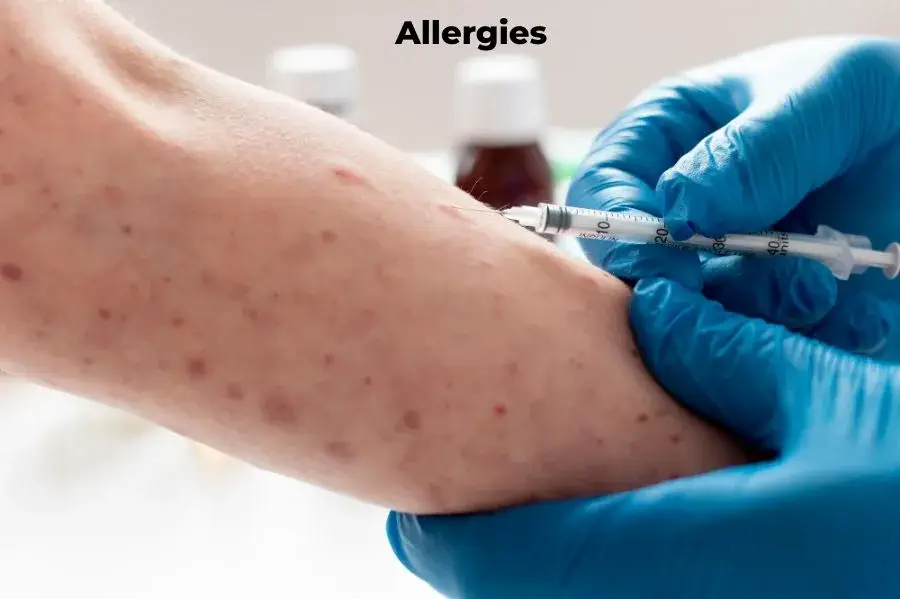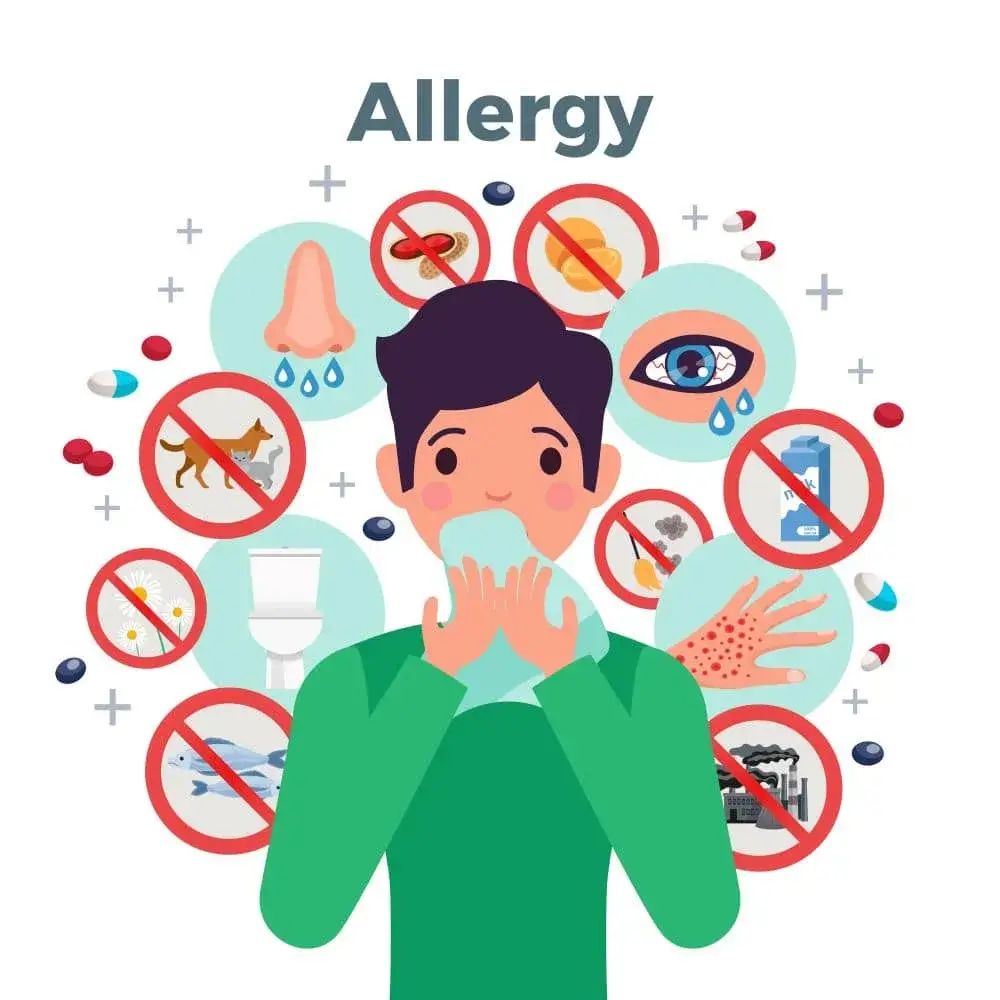- Latex allergy is an immune system reaction triggered by natural rubber latex, a substance derived from the sap of the rubber tree (Hevea brasiliensis) Latex-related allergic reactions vary in severity, and some cases can be fatal. Unfortunately, there is currently no cure for this allergy, emphasizing the importance of avoiding latex exposure.
Table of Contents
Overview:
What is a latex allergy?
- Individuals with latex allergies may experience adverse reactions when exposed to latex particles through inhalation or physical contact. Symptoms include skin irritation, burning, hives, runny nose and difficulty breathing. Latex allergy management includes exposure to latex-containing products, and individuals with this condition should wear a medical alert bracelet as an extra precaution

Prevalence and risk factors:
- Latex allergies are relatively rare, affecting less than 1% of the U.S. population. Notably, the increase in latex-free powder-free gloves in healthcare settings has reduced its prevalence in recent years Although someone can have a latex allergy, some factors elevate the risk, such as repeated exposure to latex, frequent surgery, and allergy history.
Risk factors were investigated:
- 1.Repeated Latex Exposure: Occupations that require the daily use of latex gloves, such as health care providers, dentists, and beauty industry workers, are more susceptible to developing latex allergies over the long term
- 2. Less surgery: Children and adults who have a lot of surgery are at higher risk for latex allergies. Children with spinal cord injury in particular are at increased risk due to the nature of treatment with various therapies.
- 3. Allergy History: Latex allergies often coexist with other allergies, including allergic rhinitis. Furthermore, the phenomenon known as latex food syndrome links latex allergies to specific food allergies, such as bananas, kiwis, avocados and chestnuts
Types of latex allergies:
There are two primary types of allergic reactions to natural rubber latex:
- 1. IgE-mediated latex allergy (Type I): This type involves an allergic reaction to proteins from the rubber tree, triggering the immune system to produce IgE antibodies These antibodies cause allergic symptoms and are life-threatening
- 2. Cell-Mediated Contact Dermatitis (Type IV): This form of allergy manifests as irritation and inflammation of the skin (contact dermatitis), often resulting in blister formation and fluid discharge though Lifelong, although not dangerous, it can be troublesome and in some cases progress to include IgE-mediated latex allergy.
Latex allergy symptoms:
- Latex allergy symptoms range from mild discomfort to severe and potentially life-threatening reactions. These manifestations may occur immediately after hours of latex or surface. Interestingly, no symptoms of early exposure to latex can be manifested. The common symptoms are:
- 1. Skin Irritation: Exposure to latex can cause itching, inflammation, redness, and swelling. For example, lip itching after inflating a balloon or vaginitis after intimacy with a partner using a latex condom.
- 2. Rash: An itchy rash where the latex makes contact with the skin, usually within a day. This rashes can also spread to other parts of the body. It’s important to note that rashes can also be caused by unrelated factors, such as excessive use of hand sanitizer or frequent hand washing.
- 3. Bile, nasal discharge and sneezing: Itching, watery eyes, inflammation around the nose and mouth, and red and swollen eyes are common symptoms.
- 4. Difficulty breathing: In severe cases, wheezing or difficulty breathing may occur. In rare instances, anaphylaxis can be a potentially fatal allergic reaction. If someone has an allergic reaction with difficulty breathing, immediate medical attention, such as calling 911 or going to the emergency room, is important.
The root causes of latex allergic reactions:
- During an IgE-mediated allergic reaction, the immune system overreacts to a latex-like substance, which is normally harmless to most individuals This high reaction triggers the release of histamines into the bloodstream, causing various allergic symptoms like hives, runny nose, respiratory problems and more
Latex allergic reactions can be triggered by:
1. Direct Contact: Touching or coming into contact with products containing latex triggers an allergic reaction.
2. Inhalation of latex particles: Inhalation of tiny latex particles in the air can also stimulate an immune system response. Interestingly, even if the initial exposure does not result in symptoms, repeated exposure increases the severity of reactions. Each encounter can increase the susceptibility of the immune response, which can make subsequent reactions more severe.
Latex allergy diagnosis:
- If a latex allergy is suspected, your healthcare provider will perform a thorough test, ask about your symptoms, investigate your history of latex exposure and it is important to give details of other allergies, including food reactions and any relevant family history of allergies
Diagnostic tests:
1. Blood Test: Your provider may order a blood test to assess your allergic reaction to latex. This test helps identify specific antibodies indicative of an allergic reaction.
2. Skin prick test: A frequently used diagnostic tool, the skin prick test, although mildly uncomfortable, is not painful. This test involves applying a small amount of latex to your skin, typically the forearm or back. The healthcare provider then scratches or pricks the skin with a needle, allowing a trace of latex to penetrate the skin.
– Reaction Observation: If you are allergic to latex, redness and itching may appear in the area. Tall welts also look like umbrellas. These manifestations signal an active immune system response.
– Timely Assessment: The response typically takes 15 to 30 minutes, providing a quick overview of your latex allergy status.
- This comprehensive diagnostic approach enables healthcare providers to accurately identify latex allergies, laying the foundation for effective management and informed decision making about latex exposure.
Latex allergies: practical management and treatment
Latex allergy management:
- Unfortunately, there is currently no cure for latex allergies. However, individuals with this condition can take proactive steps to effectively manage and navigate daily life:
- Avoid latex products: Steering clearance is paramount for products containing latex. This includes everyday items like gloves, balloons and condoms.
- 2. Communication is key: It is important to inform healthcare providers, caregivers, teachers, and friends about your latex allergy. This ensures that people around you are aware and can take necessary precautions.
- 3. Environmental Awareness: Be careful in environments that may contain latex in the air, such as hospital rooms where latex gloves are commonly used.
- 4. Medical Alert Bracelet: Consider discussing the option of wearing a medical alert bracelet with your healthcare provider. This simple accessory can be invaluable in an emergency, quickly relaying important information about your latex allergy.
Emergency preparedness:
In the case of an IgE-mediated allergic reaction to latex, individuals may:
1. Carry injectable epinephrine: If this severe form of latex allergy is diagnosed, it is important to have injectable epinephrine on hand. This life-saving medication can quickly reverse the effects of an allergic reaction.
2. Caregiver Education: Ensure that caregivers, friends, and family members are informed of your condition and are familiar with the administration of injectable epinephrine. This knowledge is important if you are experiencing a reaction and are unable to inject yourself.
By following these proactive measures, individuals with latex allergies can enhance their safety and effectively navigate daily life while minimizing the risks associated with potential latex exposure.
Preventive measures:
- While it is impossible to prevent a latex allergy, taking proactive steps can significantly reduce the risk of experiencing an allergic reaction Here are key preventive measures.
- Avoidance of latex products: Individuals with latex allergies should diligently avoid products containing latex. This includes everyday items, medical equipment and clothing. Careful reading of labels is essential to identify potential sources of latex.
- 2. Communicating with Health Care Providers: Inform your provider of your latex allergy prior to medical procedures or dental work. Request the use of latex-free gloves and equipment to reduce the risk of exposure.
- 3. Restaurant Awareness: When dining out, especially if your latex allergy is severe, communicate with the person preparing the food. Ask to wear latex-free gloves to ensure latex-free food.
Identification of products containing latex:
- It is important to be vigilant about products that may contain latex. Avoid things like:
- Balloons
- Clothing and Shoes: Watch for elastic components in underwear, raincoats, rain boots, and soles of sneakers.
- Household Items: Beware of rubber bands, carpet surfaces, a few toys, and tape.
- Personal care products: Stay away from latex-containing sanitary napkins, condoms, diaphragms, pacifiers and nipples for baby bottles.
- Cosmetics and costumes: Some makeup, face paint and masks used in costumes may contain latex.
Foods should be mindful:
- Although most individuals with latex allergies are not allergic to these foods, it is essential to be cautious and follow the guidance of an allergy/immunology healthcare provider The foods most likely to cause a reaction are:
- Chestnut
- Fruits: Apples, bananas, avocados, peaches, kiwis, nectarines, melons, figs, papayas, and tomatoes.
- Vegetables: Potatoes, celery, carrots .
By being informed and taking these preventive measures, individuals with latex allergies can go about their daily lives with more confidence, reducing the risk of an allergic reaction.
Outlook and Forecast:
- The outlook of individuals managing latex allergies is generally positive with proper guidance from an allergist and health care provider Lifestyle adjustments and vigilance to avoid potential triggers such as specific foods play an important role in preventing allergic reactions Consult with the donor.
Life with latex allergies:
When to take treatment:
- If you suspect or have evidence of a latex allergy, you should consult with your health care provider as soon as possible. If symptoms such as swelling of the throat and difficulty breathing arise, immediate treatment is essential. In such cases, it is important to call 911 or go to the emergency room—never ignore the signs of an allergic reaction, as latex allergies can have deadly consequences.
Conclusion:
- In conclusion, the management of latex allergy requires an active agent directed by an allergist to ensure a positive approach. Lifestyle adjustments, careful avoidance of latex-containing products, and increased awareness contribute to reducing the risk of allergic reactions Seeking early treatment in the presence of symptoms and being informed about the condition through Q&A empowers individuals to live safe and fulfilling lives despite the challenges presented. Understanding the types, prevalence and preventive measures allows individuals to prioritize their wellbeing and safety and navigate their daily activities with confidence.

FAQs:
Q. What is a latex-allergy?
A. A latex allergy is an immune system reaction to proteins found in natural rubber latex, which is derived from the sap of the rubber tree. Symptoms range from skin irritation to severe reactions such as difficulty breathing. Those with latex allergies should avoid products containing latex such as gloves and some medical devices.
Q. How common are latex allergies?
A: Latex allergies are relatively uncommon, affecting about 1-6% of the general population. However, the prevalence may be higher in certain high-risk groups, such as healthcare workers who are repeatedly exposed to latex. Sensitivities vary, with some causing mild skin irritation and others causing more severe allergic reactions.
Q3: What are the types of latex allergies?
A: There are two main types of latex allergies:
1. Type 1 (immediate hypersensitivity): Characterized by an immediate immune system response, symptoms include hives, pruritus, and in severe cases anaphylaxis
2. Type 2 (delayed hypersensitivity): This type has a delayed reaction, usually appears 48 to 72 hours after exposure to latex, appears as a skin rash, and is less severe than a type I reaction.


